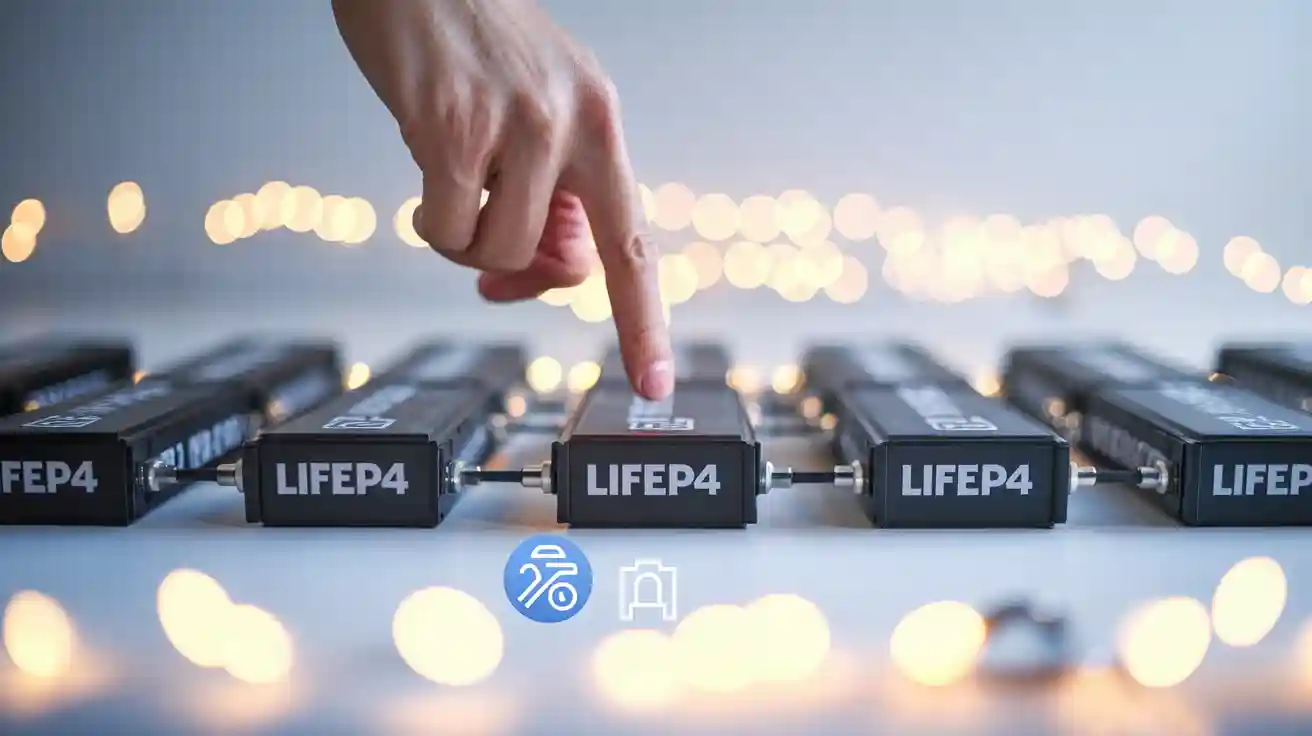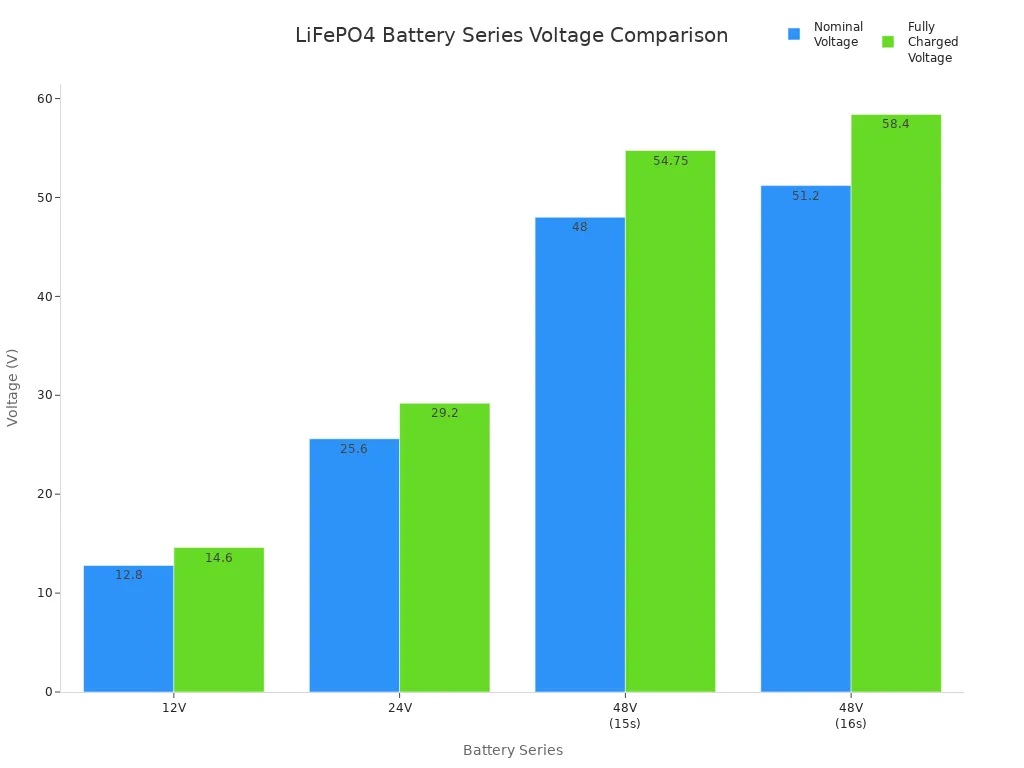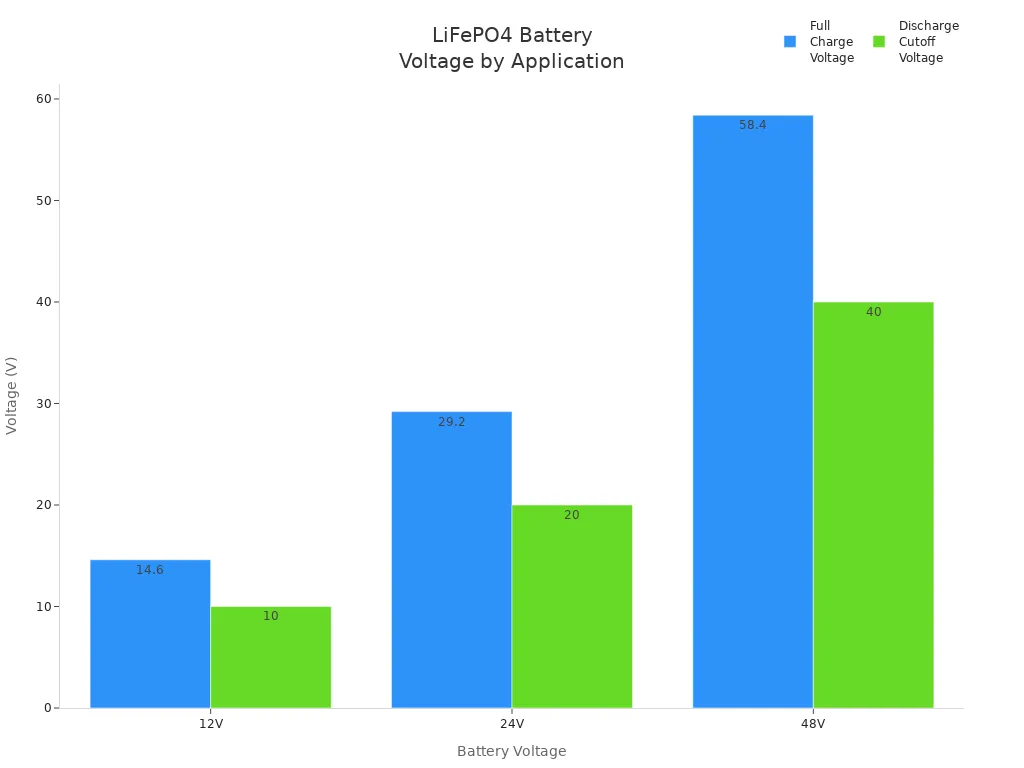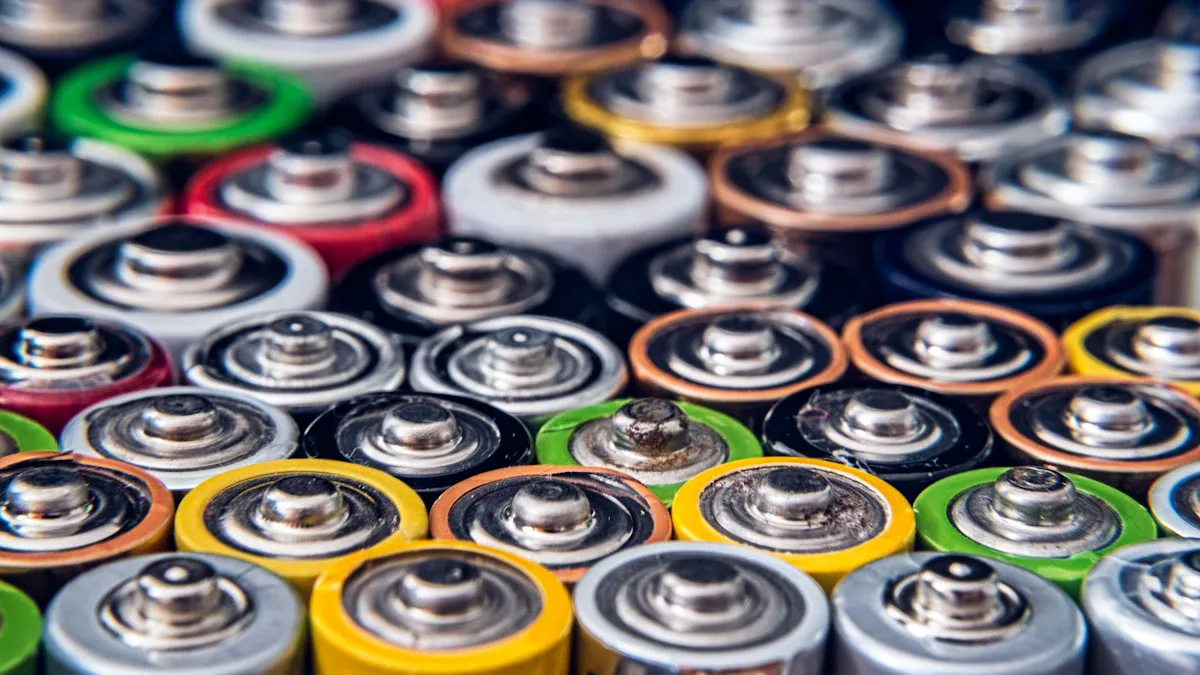
When you choose a lifepo4 battery series, you gain unique advantages over other lithium batteries. Lifepo4 chemistry gives you long cycle life, stable voltage, and strong safety. Many users pick lifepo4 for its lightweight design and low maintenance. You can trust these batteries for energy storage or any application needing reliable power. With a lithium iron phosphate battery, you avoid thermal runaway and enjoy a better total cost of ownership. Always check the bms to ensure safety, performance, and long service life.
Lifepo4 batteries work well in wide temperature ranges and need little to no maintenance. A good bms protects your investment and keeps your system running safely.
LiFePO4 Battery Series Types

When you look at lifepo4 battery series, you find several main battery types. Each type uses a different number of lifepo4 cells in series, which changes the voltage and capacity. The table below shows the most common lifepo4 battery series and their key features:
| Battery Series | Cells in Series (s) | Tension nominale (V) | Fully Charged Voltage (V) | Notes |
|---|---|---|---|---|
| 12V | 4s | 12.8 | ~14.6 | Standard 12V system |
| 24V | 8s | 25.6 | ~29.2 | Standard 24V system |
| 48V (15s) | 15s | 48 | ~54.75 | Less common, compatibility |
| 48V (16s) | 16s | 51.2 | ~58.4 | Standard for 48V equipment |

12V LiFePO4 Battery
You often see the 12v lifepo4 battery in many battery types. This battery pack uses four lifepo4 cells in series. It gives you a nominal voltage of 12.8V and a fully charged voltage near 14.6V. The 12v lifepo4 battery works well for solar energy systems, UPS systems, medical devices, and electric bikes. You also find it in camping gear, power tools, and marine batteries. Many users choose this battery type for its safety, long cycle life, and stable performance.
24V Series
The 24V lifepo4 battery series uses eight lifepo4 cells in series. This battery type gives you a nominal voltage of 25.6V. You can use it for larger solar setups, electric vehicles, and industrial equipment. The 24V battery pack supports higher power needs and longer runtimes than the 12v lifepo4 battery.
36V Series
A 36V lifepo4 battery series uses twelve lifepo4 cells in series. You see this battery type in electric bikes, golf carts, and marine vehicles. It offers extended range and consistent power. Many mobility scooters and electric wheelchairs use this battery pack for dependable energy and quick charging.
48V Series
Les 48V lifepo4 battery series stands out for high energy density and efficiency. You find this battery type in renewable energy storage, off-grid systems, and commercial backup power. The 48V battery pack uses either 15 or 16 lifepo4 cells in series. It gives you long cycle life, strong safety features, and easy integration with solar and wind systems. You also benefit from minimal maintenance and environmental advantages.
High-Capacity Series
High capacity lifepo4 battery series use many lifepo4 cells in both series and parallel. You see these battery types in large-scale energy storage, microgrids, and EV charging stations. Some high-capacity batteries reach 48V and 150Ah or more. These batteries support heavy-duty loads and critical backup power for homes, hospitals, and data centers. Lithium iron phosphate chemistry gives you safety, long service life, and reliable performance.
LiFePO4 Cells and Formats
When you choose lifepo4 batteries, you need to know about the different types of lifepo4 cells. Each cell format has unique features that affect how your battery performs, how long it lasts, and where you can use it. The three main types of lifepo4 cells are cylindrical, prismatic, and pouch. You will see these lifepo4 cells in many lifepo4 batteries for different uses.
Cylindrical Cells
Cylindrical lifepo4 cells look like small metal cans. You find them in many lifepo4 batteries because they are strong and easy to make. These lifepo4 cells work well in high-performance devices and tough environments. You often see them in power tools, electric bikes, and even space robots.
Voici un tableau montrant common sizes for cylindrical lifepo4 cells:
| Cell Size | Diameter (mm) | Length (mm) | Typical Capacity (mAh) | Tension (V) | Taux de décharge (C) |
|---|---|---|---|---|---|
| 26650 | 26 | 65 | 2500 – 4200 | 3.2 | 1C – 30C |
| 18650 | 18 | 65 | ~1100 – 1300 | 3.2 | up to 30C |
| 14430 | 14 | 43 | ~300 – 450 | 3.2 | ~1C |
| 14505 | 14 | 50 | ~300 – 650 | 3.2 | ~1C |
| 40130 | 40 | 130 | 10000 | 3.2 | 10C |

You get long cycle life and strong safety with these lifepo4 cells. The metal case protects the cell from damage. Cylindrical lifepo4 cells also handle heat well and resist swelling.
Prismatic Cells
Prismatic lifepo4 cells have a flat, rectangular shape. You see these lifepo4 cells in lifepo4 batteries for electric vehicles and energy storage. The shape lets you pack more lifepo4 cells into a small space. This means you get higher energy density and lighter batteries.
- Prismatic lifepo4 cells fit together with little wasted space.
- The flat shape helps with cooling and makes the battery pack stable.
- You can build modular battery packs with prismatic lifepo4 cells for many uses.
Prismatic lifepo4 cells also have a strong metal case. This gives you better protection from shocks and vibration. You get fewer electrical connections, which lowers the chance of problems during use.
Tip: If you want a battery pack that is slim and easy to cool, prismatic lifepo4 cells are a smart choice.
Pouch Cells
Pouch lifepo4 cells use a thin, flexible bag instead of a hard case. These lifepo4 cells are very light and can be made in many shapes. You find pouch lifepo4 cells in wearables, drones, and medical devices.
| Aspect | Pouch LiFePO4 Cells | Explanation |
|---|---|---|
| Poids | Lightweight | Pouch cells weigh less than prismatic cells, making devices easier to carry and more efficient. |
| Coût | Cheaper | Fewer parts and simpler design reduce manufacturing costs, making pouch cells more affordable. |
| Heat Management | Effective heat control | Flexible casing allows heat to dissipate, improving lifespan, performance, and safety. |
| Shape and Versatility | Highly adaptable and customizable | Can be made in various shapes and sizes to fit unique device designs like wearables. |
| Durée de vie | Shorter cycle life | Tend to degrade faster, requiring more frequent replacements or maintenance. |
| Physical Durability | Fragile to impacts | Lack of rigid casing makes them vulnerable to punctures and mechanical stress. |
| Safety Concerns | Potential swelling under high temperature or overcharging | Swelling can cause leakage or damage; requires careful handling and thermal management. |
Pouch lifepo4 cells give you high energy in a small space. You must protect these lifepo4 cells from bumps and pressure. Swelling can happen if you overcharge or use them in hot places. Always use a good battery management system (BMS) to keep pouch lifepo4 cells safe.
Applications of LiFePO4
Véhicules électriques
You see lifepo4 batteries powering many véhicules électriques today. These batteries give you long cycle life and stable voltage. Electric vehicles like cars, buses, and scooters use lifepo4 for safety and reliability. The lightweight design helps vehicles go farther on a single charge. You also get fast charging, which means less waiting and more driving. Many people choose lifepo4 for electric vehicles because these batteries last thousands of cycles and need little maintenance. This makes them a top choice in the growing energy storage market.
- Electric vehicles
- Rail transit
- Small electric vehicles like scooters and bikes
Solar Energy Storage
Lifepo4 batteries work very well in solar energy storage systems. You can store solar power during the day and use it at night or during cloudy weather. These batteries have high charge and discharge efficiency, often over 90%. This means you lose less energy when storing and using solar power. Lifepo4 batteries also have a low self-discharge rate, so they keep energy for a long time. Their long lifespan, often 10 to 15 years, lowers replacement and maintenance costs. You can use lifepo4 batteries in home energy storage systems and large solar energy storage projects.
Tip: Lifepo4 batteries help you get the most from your solar panels by storing more energy in less space.
Marine and RV
You can trust lifepo4 batteries for marine and RV use. These batteries are lightweight, which helps with fuel efficiency and stability. Lifepo4 batteries have a long lifespan and can handle thousands of charge cycles. They also work well in a wide range of temperatures. Safety features like advanced battery management systems protect against overcharging and overheating. You can charge these batteries quickly, which is great for long trips. Many marine and RV users switch to lifepo4 for better performance and less maintenance.
| Key Feature | Benefit for Marine and RV Users |
|---|---|
| Lightweight | Easier handling, better fuel efficiency |
| Long lifespan | Fewer replacements, lower costs |
| Chargement rapide | More time on the road or water |
| Safety features | Peace of mind in enclosed spaces |
Backup Power
Lifepo4 batteries play a big role in backup power systems. You can use them for homes, businesses, and hospitals. These batteries last much longer than lead-acid batteries. Lifepo4 batteries can reach up to 10,000 cycles, while lead-acid batteries often last only a few hundred cycles. You do not need to check fluids or clean terminals, so maintenance is easy. Lifepo4 batteries also provide steady power during outages, making them a smart choice for backup power systems.
Utilisation industrielle
Many industries use lifepo4 batteries for energy storage. You find them in factories, warehouses, and remote monitoring equipment. Lifepo4 batteries power robotics, scissor lifts, and even weather stations. Their long cycle life and fast charging help keep operations running smoothly. These batteries also work well in extreme climates, from the Arctic to deserts. The energy storage market values lifepo4 for safety, reliability, and low maintenance. You can scale up energy storage systems by adding more batteries as your needs grow.
- Industrial power systems
- Renewable energy systems (solar, wind)
- Remote monitoring and backup power
Selecting a LiFePO4 Battery Series
Choosing the right lifepo4 battery series helps you get the best performance, safety, and value for your application. You need to look at several key factors before you decide. These include voltage, capacity, C-rate, depth of discharge, cycle life, bms features, size, weight, and the environment where you will use the batteries. Let’s break down each factor so you can make a smart choice.
Tension et capacité
You must match the voltage of your lifepo4 battery pack to your system’s needs. If you use the wrong voltage, your devices may not work or could get damaged. Capacity tells you how long your batteries will last before you need to recharge them. Higher capacity means longer runtime.
Here is a table to help you see which voltage and capacity fit common uses:
| Battery Voltage | Tension de charge complète | Discharge Cutoff Voltage | Typical Application Scenario | Capacity and Usage Notes |
|---|---|---|---|---|
| 12V | 14.6V | 10V | Home solar systems, small RV setups | Good for smaller systems; safe and easy to manage. Capacity scales with voltage. |
| 24V | 29.2V | 20V | Medium to large solar setups | Better for bigger solar systems; higher voltage lowers current and wiring costs. |
| 48V | ~58.4V | ~40V | Large solar power, backup power | Best for large systems; keeps amperage low, increases lifespan and capacity. |

Tip: Use a battery monitor or app to keep track of voltage and capacity. This helps you avoid overcharging or deep discharging, which can damage your lifepo4 batteries.
C-Rate and Power Needs
C-rate tells you how fast you can safely charge or discharge your lifepo4 battery pack. You must pick a battery with the right C-rate for your power needs. If you use a battery with a low C-rate in a high-demand device, you risk overheating and shorter cycle life.
- Low C-rate (1C–2C): Good for steady, long-term power in home energy storage or UPS.
- Medium C-rate (3C–5C): Works well for electric vehicles and power tools.
- High C-rate (6C–10C+): Needed for racing cars, drones, or other high-performance uses.
Expion360 recommends a maximum discharge rate of 1C and a recommended rate of 0.5C for lifepo4 batteries. This means you can safely use the battery at its full capacity for short bursts, but it lasts longer if you use it at half that rate. Always check your device’s power needs and choose a battery pack that matches or exceeds those needs for improved safety and longer cycle life.
Depth of Discharge and Cycle Life
Depth of discharge (DoD) shows how much of your battery’s capacity you use before recharging. If you use most of the battery’s energy every time (deep discharge), you shorten its cycle life. If you recharge before the battery gets too low (shallow discharge), you get more charge-discharge cycles and a longer lifespan.
| Depth of Discharge (DoD) Range | Cycle Life (before 10% capacity loss) | Notes |
|---|---|---|
| 72% – 98% (Deep Discharge) | ~2000 cycles | More stress, faster wear |
| < 72% (Shallow Discharge) | > 5000 cycles, up to 10,000 cycles | Less stress, much longer battery life |
Note: Try to keep your DoD around 80%. Avoid letting your lifepo4 battery pack drop below 20% before recharging. This practice gives you a longer cycle life and better performance.
BMS and Safety
The bms is the brain of your lifepo4 battery pack. It gives you protection and keeps your batteries safe. A good bms includes:
- Over-current, over-voltage, under-voltage, and over-temperature protection.
- Cell balancing to make sure each cell charges and discharges evenly.
- Communication features like Bluetooth or CANBUS for easy monitoring.
- Diagnostics and data logging for tracking battery health.
- Thermal management to prevent overheating or charging in freezing temperatures.
Some bms models, like the AY-L24S300A-ES001, offer advanced features such as active cell balancing, high current capacity, and communication options. These features give you enhanced safety and improved safety for your system. Lifepo4 batteries use environmentally friendly materials and have high safety due to their stable chemistry. You also get safety protections from the bms, which lowers the risk of fire or explosion.
Always choose a lifepo4 battery pack with a smart bms. This ensures your batteries last longer and stay safe, even in tough conditions.
Size, Weight, and Environment
You need to think about where and how you will use your lifepo4 batteries. Size and weight matter most for mobile uses like RVs, boats, or portable power stations. Lifepo4 batteries weigh about one-third as much as lead-acid batteries with the same capacity. This makes them easy to move and install.
- For mobile use, pick a smaller, lighter battery pack (like 300Ah) for easy handling.
- For stationary use, you can use a larger battery pack (like 400Ah) for longer runtime.
- In cold climates, choose a bigger battery to make up for lost capacity in low temperatures.
- Lifepo4 batteries work well from -20℃ to 60℃, so you can use them in many environments without worry.
If you have limited space, go for a compact battery pack. If you need long backup times or live in a cold area, a larger battery gives you steady power.
Practical Scenarios
- Solar Energy Storage: For a small home solar setup, a 12V or 24V lifepo4 battery pack with a smart bms and moderate capacity works well. For large solar arrays, use a 48V battery pack with high capacity and advanced bms features.
- RV and Marine: Choose a lightweight, compact lifepo4 battery pack with high safety and strong protection. Make sure the bms can handle vibration and temperature swings.
- Backup Power: Pick a 48V lifepo4 battery pack with a long cycle life and robust bms. This gives you reliable power during outages and keeps your system safe.
Remember: Always check the voltage, capacity, C-rate, DoD, cycle life, bms features, size, weight, and environmental needs before you buy. This helps you get the best performance, safety, and value from your lifepo4 batteries.
Series and Parallel Configurations

When you build a battery pack, you can connect cells in series, parallel, or both. Each method changes how your battery pack works. You need to know the difference to match your system’s needs and keep everything safe.
| Configuration | Effect on Voltage | Effect on Capacity | Example |
|---|---|---|---|
| Series | Increases total voltage while capacity remains the same | Capacity stays the same | 8 cells of 3.2V 100Ah connected in series yield 24V 100Ah pack |
| Parallel | Voltage remains the same | Increases total capacity by summing individual capacities | 8 cells of 3.2V 100Ah connected in parallel yield 3.2V 800Ah pack |
Série Connexion
You use a series connection when your device needs higher voltage. In this setup, you connect the positive terminal of one cell to the negative terminal of the next. The total voltage adds up, but the capacity stays the same. This method works well for:
- High-voltage portable electronics
- Electric bicycles and skateboards
- Medical devices that need specific voltages
- Scientific instruments
- Industrial and commercial backup systems
Series connections let you power devices that need more voltage than a single cell can provide. You also get simpler wiring and can use thinner wires, which saves space and cost. You must use a bms that can monitor each cell in the series. If one cell fails, the bms will alert you and protect the whole pack.
Tip: Always use cells with similar age and health in a series pack. The bms will help balance the cells and prevent problems.
Connexion en parallèle
You use a parallel connection when you want to increase the total capacity of your battery pack. Here, you connect all the positive terminals together and all the negative terminals together. The voltage stays the same, but the capacity adds up. This setup is great for systems that need longer runtime at the same voltage.
When you connect batteries in parallel, you must follow safety steps:
- Make sure all batteries have nearly the same voltage before connecting (within 0.1–0.2V).
- Use thick, equal-length cables to keep resistance balanced.
- Connect all terminals securely.
- Choose a bms designed for parallel setups to monitor and balance the pack.
- Use a charger that matches the voltage but can handle the total capacity.
- Check the pack often for voltage balance and temperature.
A good bms will watch for overcharging, overdischarging, and temperature spikes. It will also balance the cells and keep your pack safe. You should install fuses on each positive terminal and use high-quality insulation. Regular checks with a multimeter or infrared camera help you spot problems early. Cooling and ventilation systems can prevent overheating.
Note: Never skip the bms when building a parallel pack. The bms is your best tool for safe, reliable battery operation.
Understanding LiFePO4 battery series types, cell formats, and selection criteria helps you choose the safest and most effective solution for your needs. Always match battery voltage, capacity, and management systems to your application. For best results:
- Use chargers designed for LiFePO4 batteries.
- Monitor batteries with a reliable BMS.
- Inspect connections and battery health regularly.
New advances in materials, smart management, and safety features make LiFePO4 batteries even more reliable. Stay informed about ongoing research to benefit from future improvements in energy storage.
FAQ
What makes LiFePO4 batteries safer than other lithium batteries?
You get better safety because LiFePO4 batteries resist overheating and do not catch fire easily. The chemistry stays stable, even if you overcharge or damage the battery. You can trust them for home, RV, or solar use.
How do you store LiFePO4 batteries for long periods?
Store your battery in a cool, dry place. Charge it to about 50% before storage. Check the battery every few months. Avoid extreme heat or cold. This helps your battery last longer.
Can you use a regular charger with LiFePO4 batteries?
You should use a charger made for LiFePO4 batteries. Regular chargers may not charge to the correct voltage. This can damage your battery or reduce its lifespan.
How do you know when to replace a LiFePO4 battery?
Look for signs like shorter runtime, slow charging, or swelling. If your battery does not hold a charge or the BMS shows errors, you should replace it. Always follow the manufacturer’s advice.

